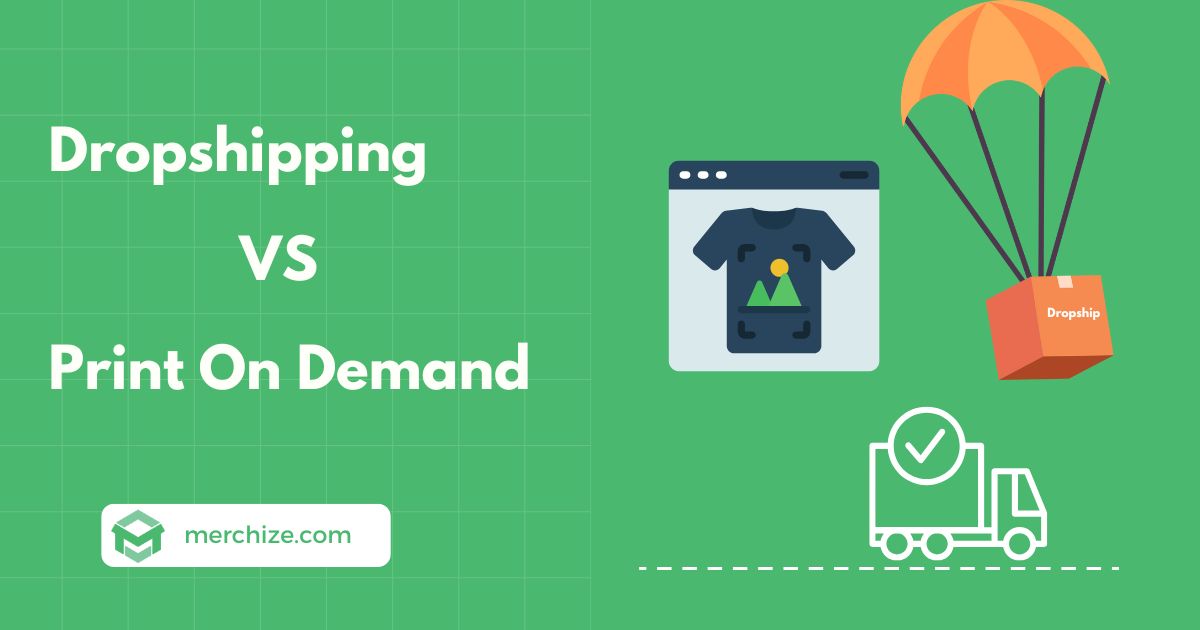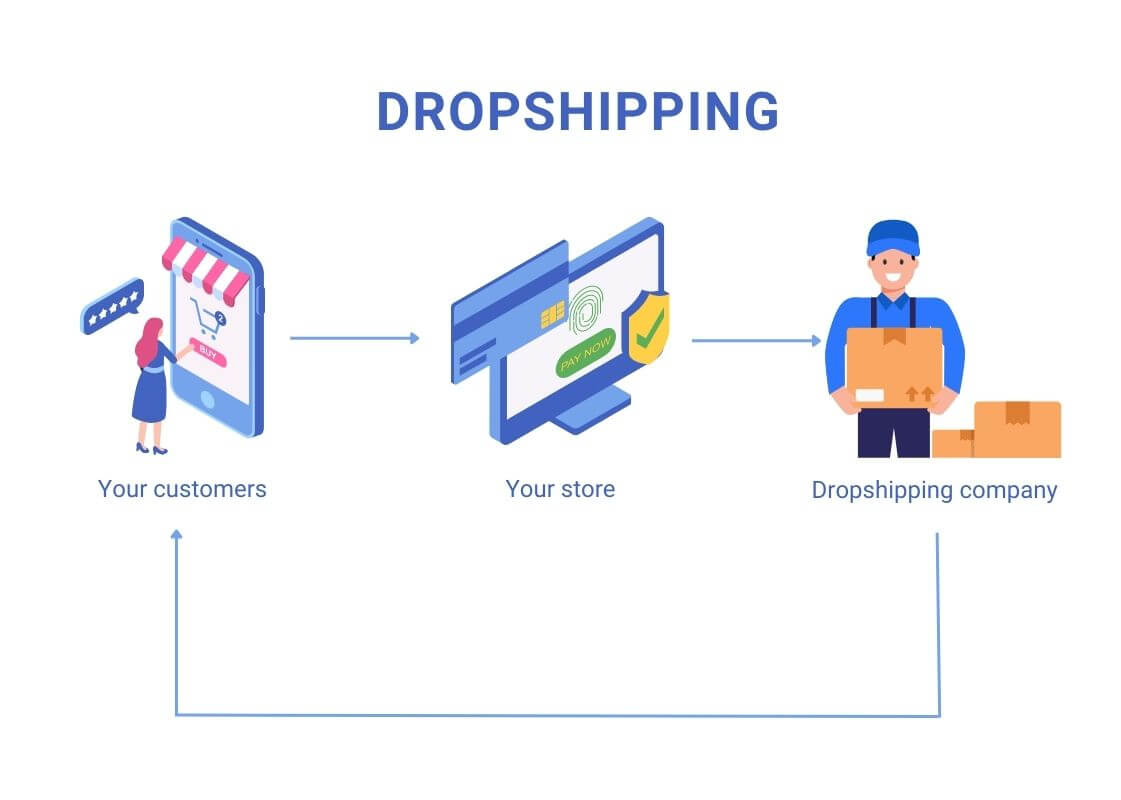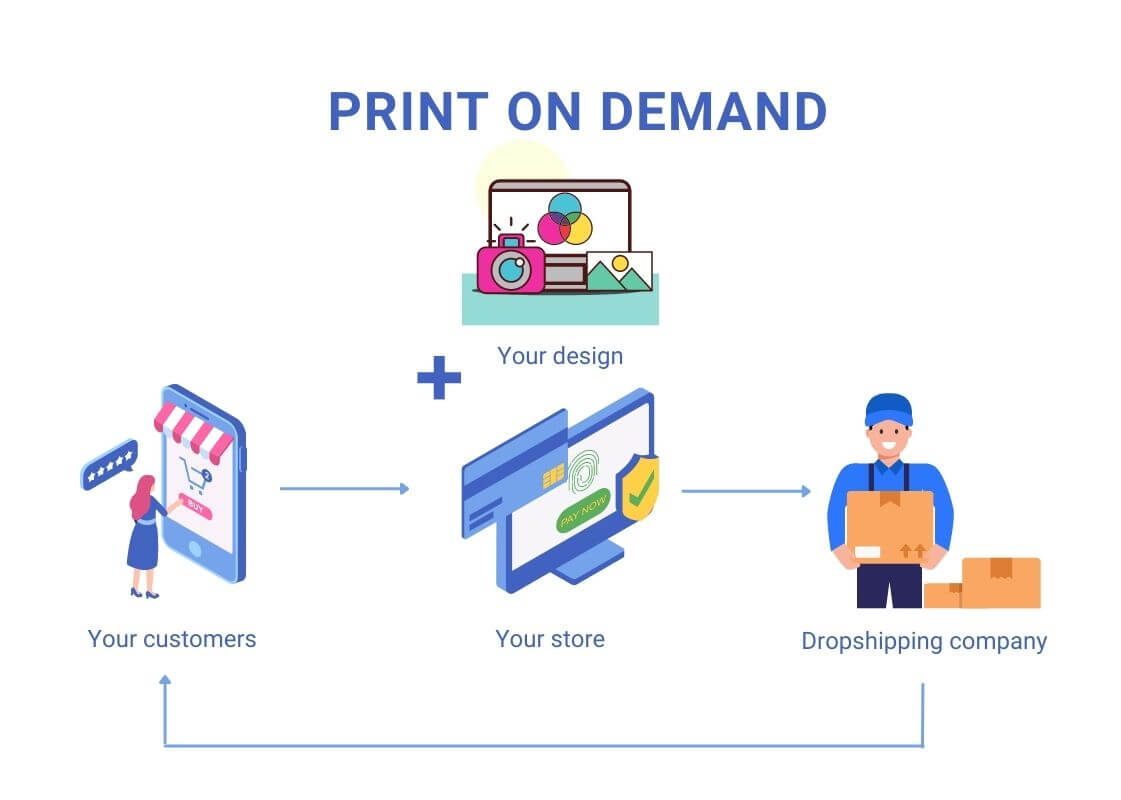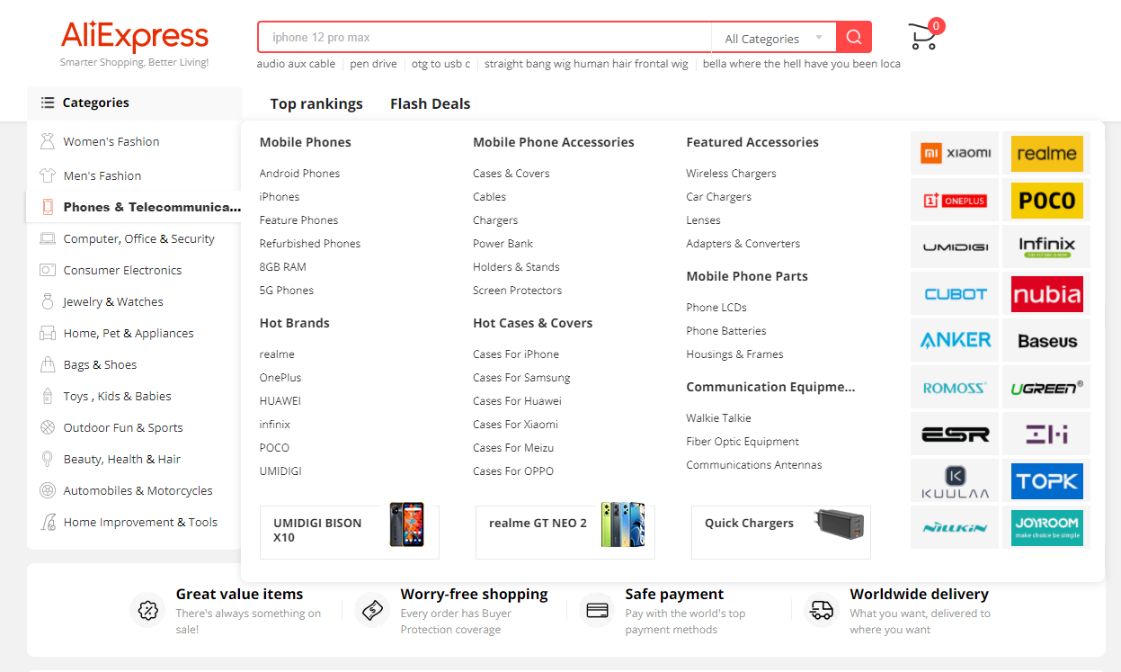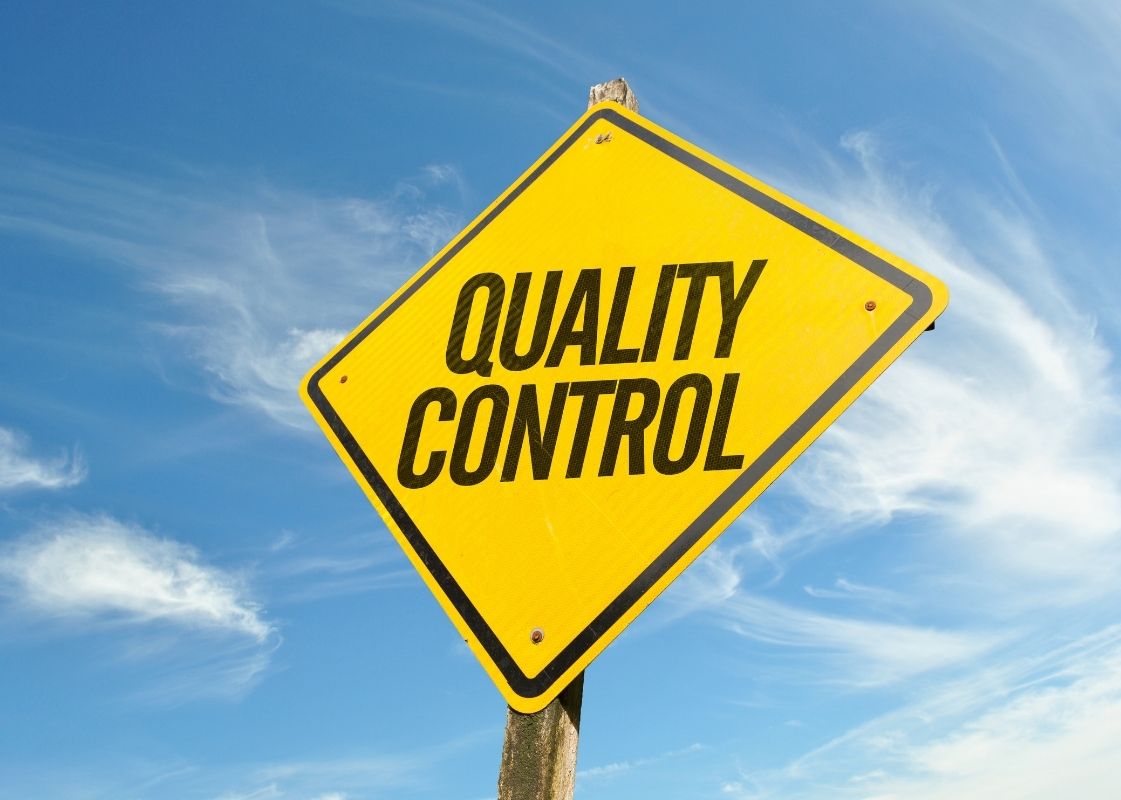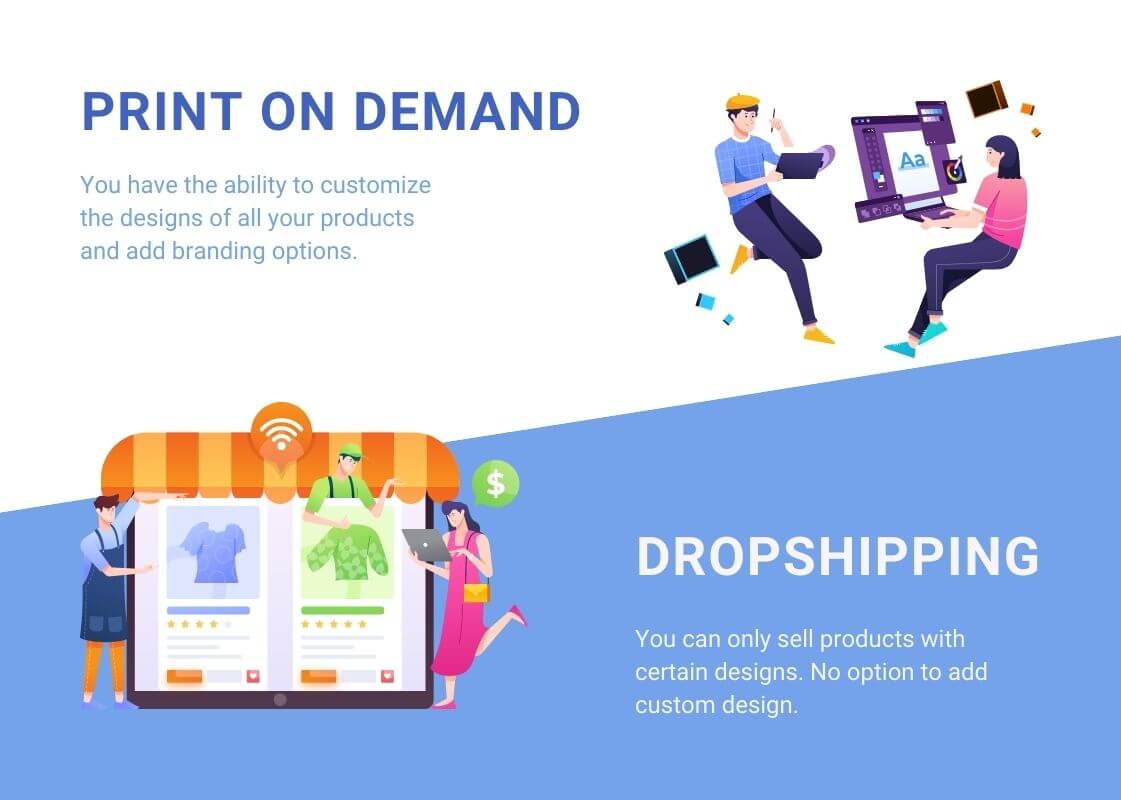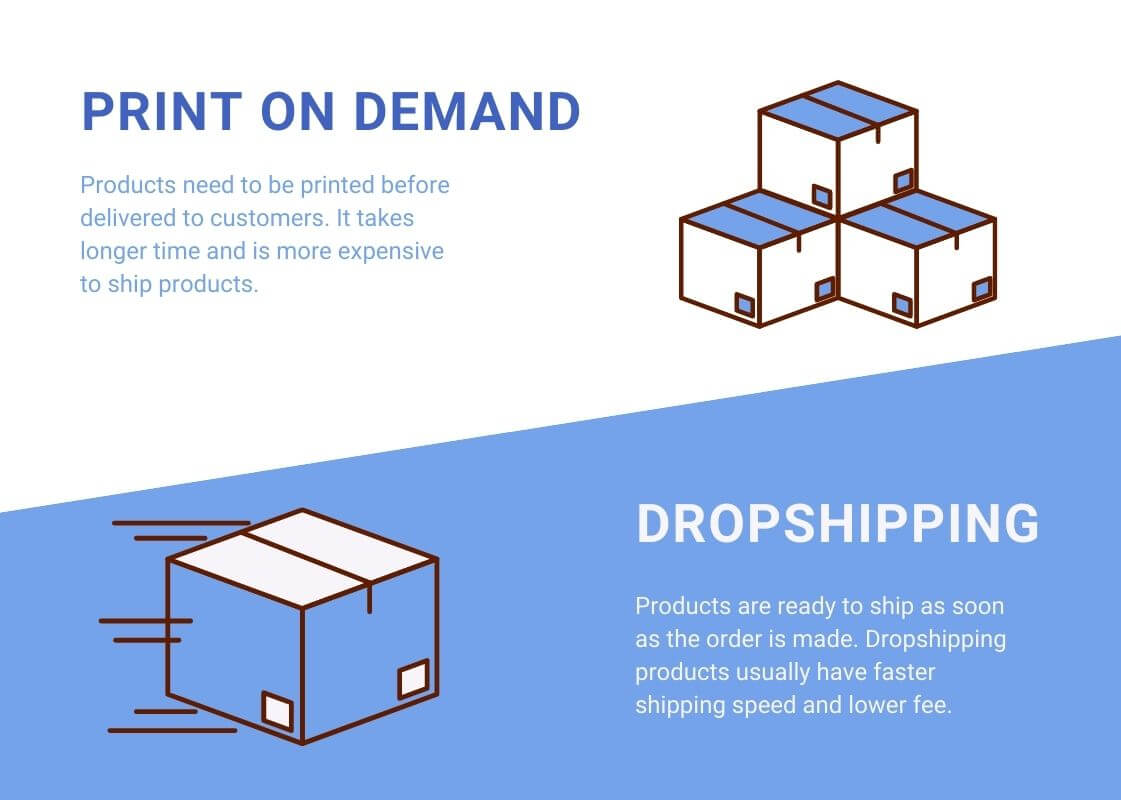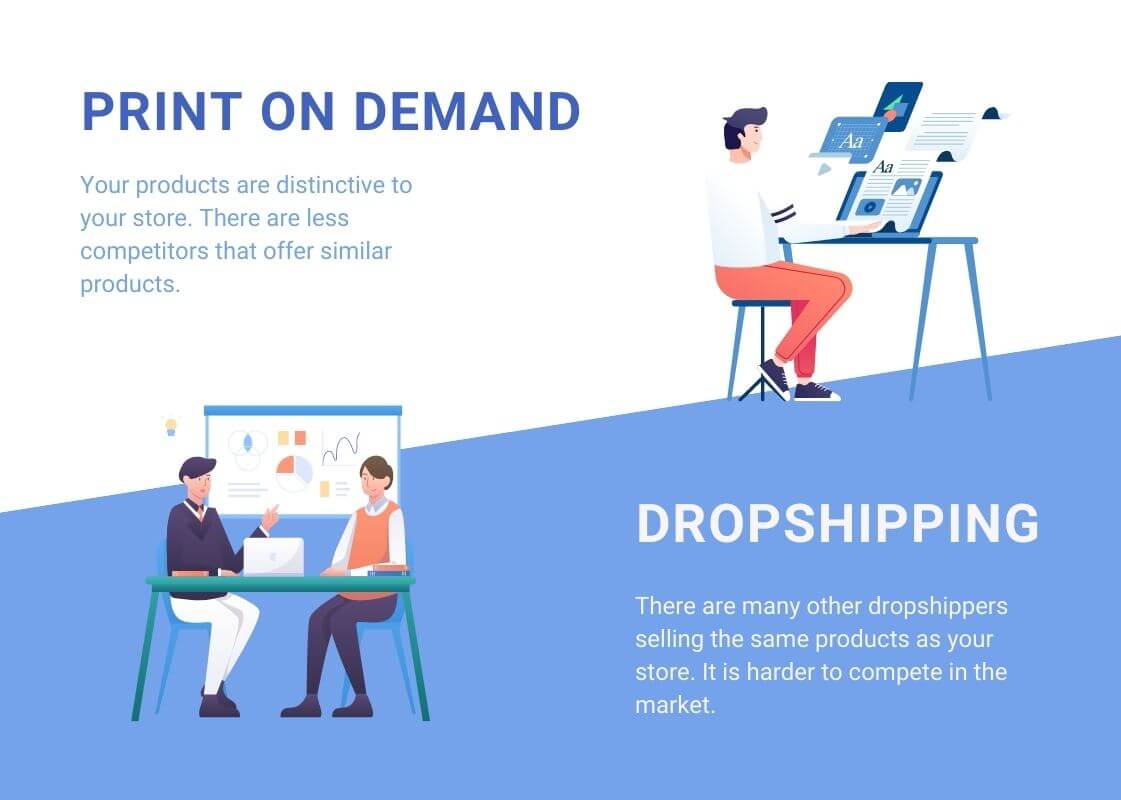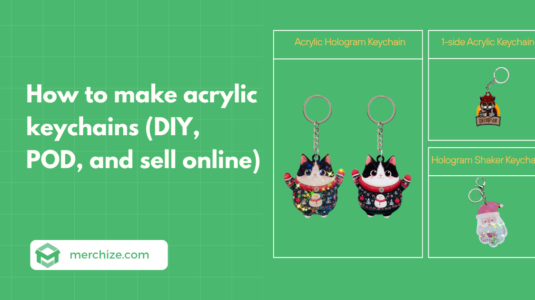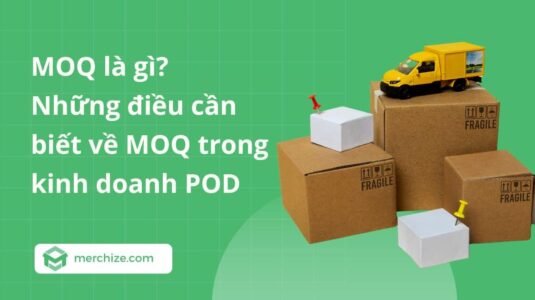Contents
Dropshipping and print on demand have become popular ecommerce models for aspiring online entrepreneurs. These fulfillment methods allow easy entry for ecommerce beginners, with low startup costs and no inventory requirements.
But some starters may feel confused about the differences between the two models and which is best suited for their goals and product focus. To clear up the confusion, this article will explain in detail about drop shipping and print on demand, their pros and cons and how you can find which one is suitable for your business.
What is dropshipping?
In order to find the answer to the question “Whether print on demand or dropshipping is the best option?”, we need to address the fundamentals of each business model first.
Dropshipping is a special solution for the ecommerce business. It is a form of fulfillment which requires no inventory to sell products.
In order to fulfill orders, the sellers now work with a third-party, either a wholesaler or a manufacturer, who will take care of the inventory and delivery. Sellers only have to pay when an order is confirmed.
What differentiates dropshipping business from the regular retailing model is the fact that the business owner doesn’t actually buy or own the products. Instead, they act as a middle man between end customers and dropshipping suppliers.
Dropshipping is a less risky and low-barrier business model to make money online.
What is print on demand?
Print on demand is considered a dropshipping model, but with a twist. With print on demand, sellers’ role is more than just a middleman whose job is to sell products only. Instead, they contribute to the production of their goods by creating the designs.
The print on demand suppliers will help them to print their designs into the white-label products and deliver them to the buyers. A printing company either owns the manufacturing or outsources the printing services in order to fulfill the orders. You can read our post to fully understand what is print on demand and how it works.
Print on demand is a form of dropshipping where products are printed in order using your own designs.
Dropshipping vs Print on demand: What are the similarities?
From the definition of dropshipping and print on demand as explained above, it is easy to see that both of these business models are similar in some obvious ways.
No inventory
First off, both dropshipping and print on demand requires no inventory. It’s the print on demand and dropshipping suppliers who hold inventory. This characteristic of these two models help sellers to save money on leasing and managing inventory.
No managing shipping
Apart from the inventory, sellers doing dropshipping and print on demand also don’t need to stress over the shipping of the products. Print on demand and dropshipping suppliers will print, package and ship all orders on your behalf. It will take a chunk of work off your shoulders.
Low risk
Another important peak that both models have is the absence of unsold stock risk because all orders are delivered on demand. It means that you only have to pay for the product when the order is made.
These two different business types are unlike traditional retailing where you pay for products up front and keep them in inventory. In the traditional business model, you are running the risk of not clearing out all products on stock, which translates into a loss in profit.
Passive income
Ideally speaking, both print on demand and dropshipping are sources of passive income: Money is running into your pocket without you spending hours and doing the work. Of course, you need to deliver the minimum effort in order to set up the store and the listing, but these attempts are on-time events. But everything after that is automated and you can probably earn money even in your sleep.
Easy to start and experiment
For both dropshipping and print on demand business, the entry barrier is low. It might take a small cost to set up a place where online buyers can visit and buy your product in the beginning. Without the need to buy products in bulk and keep the inventory, it does not require large investment like the traditional business. It offers an opportunity for anyone to start doing business online with a small budget.
More importantly, dropshipping and print on demand also provide an opportunity for business owners to expand their existing business with a new line of product without risking spending huge money up front. With print on demand and dropshipping, they can test new products to see whether their customers like it or not before getting all in. That’s why many traditional business owners are using dropshipping and print on demand to fulfill a number of products in their store.
Skills set
Success in dropshipping and print on demand probably requires a similar set of skills. For example, to get traffic to your stores, dropshipper and print on demand sellers must do some sort of advertising and marketing, which can be through social media, email, SEO, or paid ads.
In addition to the marketing and advertising skills, print on demand and dropshipping sellers also need to master the art of market research, customer services, budgeting and many more.
What are the differences between dropshipping vs print on demand?
Beside what they have in common, print on demand and dropshipping have some distinctive features that set them apart. Knowing these differences will help you decide which one is better for you.
Products
The first thing to mention is that each model will have a different approach to manage the production, which leads to different outcomes in terms of product range and product quality.
Product range
Print on demand focuses on the products that can be customized and printed, including apparels like T-shirts, hoodies, home and living items like mugs, posters, canvas, and accessories like phone cases, keychains, jewelry and so on.
Unlike dropshipping where all products are ready-to-sell, a print on demand product needs to be printed before being shipped to the customers. One print on demand company wouldn’t have all the capabilities to make and print all kinds of products. On average, a print company can provide a set of 100-400 products. Even when adding all of the products of these print on demand companies together, we can’t have as many products as dropshipping.
Dropshipping allows sellers to access a wider range of ready-made products to sell, from phone cases to kitchenware. Print-on-demand has a more limited product selection, but works well for customized apparel like t-shirts, sweatshirts, and other merchandise.
On the contrary, there is a vast number of products for you to start selling. Basically, you can find all products to fulfill for your dropshipping store, from clothing, accessories to heath and beauty products, electronic gadgets and devices. The opportunities are endless.
Who wins? Dropshipping
Product cost
Product cost is a key factor determining the success of a business. If you can lower the product cost, you can have more competitive prices and higher profit margins.
Out of the two models, dropshipping is the one that can offer a much more appealing price. It is reasonable since print on demand products are printed in order. They are also highly customizable, which justifies the higher price.
Who wins? Dropshipping
Quality control
Product quality is a discernible weakness of both dropshipping and print on demand services. Because sellers don’t own the inventory or hand the products at hand. Everything is handled by dropshipping or print on demand suppliers, making it hard to control the quality of products.
In order to know the quality of the products, you need to order samples to check the quality before making the decision.
However, quality control can be a bit more challenging for dropshipper than for print on demand sellers. The reason is that print on demand has a smaller number of products. And with each product, you can literally create multiple listings using different designs. Consequently, you can order one sample for a series of products for your online store.
For dropshipping, you need to order for every product on your product catalog in order to assess the quality, which can be increasingly hard with a high-volume store. If you are doing dropshipping, the best thing you can do to assure the product quality is to stick to reliable dropshipping companies.
Who wins? Print on demand
Customization
65% of customers agreed that they preferred personalized products over the standard products. GenZ is the group that shows the strongest tendency with 74% agreeing with this statement.
If you can use personalization to your advantage, you can draw more customers and increase the conversion rate as well as your profits.
Fortunately, print on demand allows you to offer products with custom designs on your store. Print on demand products are made in order. It is only printed when the order arrives, which introduces a wonderful opportunity to sell personalized products and make more money. Moreover, people are also willing to pay more to get the customized products, which can increase your bottom line significantly.
Unlike print on demand services, dropshipping is all about ready products that can’t be customized in order.
Who wins? Print on demand
Shipping
Shipping is a big concern for every ecommerce business. The shipping time and shipping costs more often than not influence the overall buying experience of the online shopper.
With print on demand and dropshipping, shipping is handled by the suppliers, not the seller. However, each model will have a different shipping process which can affect the shipping time and cost.
Shipping time
There are a lot of factors in play when it comes to the shipping time calculation.
- Location of the fulfillment center:
The nearer the fulfillment center is to the customers, the faster the shipping process is. Virtually, suppliers can have fulfillment centers across different countries. However, the biggest market for print on demand and dropshipping is still the US. Other European countries are also big spenders of dropshipping and print on demand products.
Considering that the majority of buyers come from North America and Europe, choosing the suppliers with fulfillment centers in these areas is highly recommended and best for shipping.
But keep in mind that the biggest dropshipping supplier is AliExpress – a China-based dropshipping company owned by Alibaba. If you choose AliExpress as your dropshipping supplier, the shipping can take longer than if you do print on demand with suppliers located in North America or Europe.
- Time of production:
After the order is made, the dropship product will be ready and sent right away to the customer’s address. In the case of print on demand, after the order is confirmed, the product will enter the printing process before sending to customers as a completed item.
Depending on the type of print on demand product, the production time can take from one to five or six days. The product time will significantly increase the total shipping time, extending the wait. Both the printing and shipping can take up to one or two weeks to finish.
The conclusion is that the shipping time for print on demand and dropshipping can vary depending on the location of the fulfillment center. Putting aside the location factor, print on demand generally takes longer for the shipping process.
Shipping costs
The shipping costs are dependent on the location of the print on demand production center and dropshipping warehouse. Apparently, the closer these sites to where your customers locate, the lower shipping cost is. Considering that it is easier for the dropshipping companies to establish a warehouse to store their products than it is for print on demand to build a production center, dropshipping has more flexibility to expand their warehousing network, thus, reducing the shipping time and shipping costs.
Who wins? Depends (Dropshipping most likely to win)
Profit margins
The drive behind every business is profit. Drop shipping and print on demand business are not exceptions.
Considering the profit margins, dropshipping has an upper hand over print on demand. Dropshipping products are provided by wholesalers and manufacturers at a very good price. These products go without branding, which cuts down the cost significantly.
Plus, dropshipping requires less work than print on demand to maintain. If you do print on demand, you either have to spend time and effort to create designs or hire a graphic designer to do the work. Whereas, with dropshipping, what you need to do is push that listing to your store and have the drop shipping company take care of the rest.
So, which one is more profitable, dropshipping or print on demand?
While dropshipping has a higher profit margin, print on demand is in fact more sustainable in the long run. If you can put in hard work and create a strong brand for your print on demand store, you can make incredible profit out of your online business.
Dropshipping, on the other hand, is faster to generate sales and profit. But it can be difficult to establish a brand and continuously grow over time.
Who wins? Dropshipping
Entry barrier
Sometimes what stands between you and the success you’ve dreamt of is taking the first step. That’s why finding an easy-to-enter business can be very important.
Compared to print on demand, dropshipping is quicker and less complicated to start. Apparently print on demand providers and dropshipping suppliers take nothing to register and start selling. However, with print on demand, you will need to come up with the design and ideas as well as create mock-ups and images before adding these products for sale.
On the other hand, with dropshipping, you can select from the pool of products and start listing these for products for sale right away.
Who wins? Dropshipping
Branding
The ability to establish your own brand is an advantage for print on demand business over other dropshipping.
In print on demand, you are contributing to the creation of your products by creating the designs and defining the look. This way, you can integrate your brand image into the products.
Besides, print on demand suppliers also offer various options to help you build your own brand. For example, sellers can use a custom label on their products, custom packing slip with message, packing insert and even custom packaging.
For dropshipping businesses, to create a brand for your own, there is less room for brand building. You can’t make your own unique product, or attach your brand to the products. What you can do to establish a brand is limited to customizing packaging and your own website.
But why pay attention to your brand, you might ask. A strong branding is undoubtedly beneficial for your online business in the long run. In the highly competitive market like ecommerce, a good brand is what makes you stand out from the crowd and keep the customers returning to your store.
Who wins? Print on demand
Opportunities for scaling
To maximize the profit, business needs room to scale up sustainably and explonently. Considering dropshipping business is easier to start and maintain, it will be easy to scale up. Another thing to take into consideration is the higher turnover of dropshipping compared to print on demand. Since the market for dropshipping products is bigger and the profit margin is higher, you will soon gather enough revenue to expand your business.
Who wins? Dropshipping
Market size
According to Statista, the global market value of dropshipping in 2020 is estimated to be 128.6 billion US dollars. In the 6 year’s time, the market size is expected to reach 476.1 billion, which is almost four times bigger than the current market size.
Another report suggests nearly 33% of online stores have adopted dropshipping. An old statistic dated back in 2017 also reveals that 23% of the online global sales were fulfilled by dropshipping. It can be said that dropshipping really has a huge market.
Compared to dropshipping, print on demand doesn’t share the same market size, which is expected because print on demand can only cover a fraction of the product types that dropshipping offers.
A larger market size translates to a higher sales volume and more opportunities. And in this area, dropshipping definitely wins over print on demand.
Who wins? Dropshipping
Competition
It is much harder to compete in dropshipping than in print on demand. This is a direct result of the bigger market size. In addition, in the drop shipping business, what you sell is not unique to your stores and there are possibly hundreds or thousands of other merchants offering the same products.
Unlike dropshipping, print on demand allows you to create custom products that can’t be found somewhere else. With dropshipping, even when they like what you’re selling, they can still go on a search for the same product with a better price somewhere else, which drives the competition to the next level.
Who wins? Print on demand
How to sell print on demand and drop shipping?
What product to sell?
There are two common approaches to decide which products to include in your store. The first option is to sell literally anything that has the potential to make profit. And the other solution is to find a niche and build your catalog around that niche. These two methods can be adopted by dropshipping and print on demand. However, there are slight differences in terms of what can sell well for each model.
Dropshipping:
With dropshipping, you have more options of what product to sell. What you need to do is find a product with high volume within your selected niches. You can do this by doing market research to know which products are selling well and have huge demand.
Popular dropshipping products:
- Health care and beauty products: Yoga mats, Vitamin C serum, Mask, tooth brushes, etc.
- Apparels: Jeans, leggings, T-shirts, etc.
- Others: Kitchenware, Home and decor, stationary, phone accessories, etc.
Print on demand:
More than the product type, print on demand requires a layer of work in terms of product research – you need to come up with ideas and designs for your products. It requires more work and understanding of your target audience to find the best print on demand products.
Popular print on demand products:
- Apparels: T-shirts, mugs, hoodies, posters, canvas, etc.
- Home and living: Posters, Wall decor, Blankets, doormat, etc.
- Accessories: Jewlery, Phone cases, etc.
Explore our all print on demand products that you can fulfill via Merchize
What companies to work with?
84% of ecommerce sellers agree that finding a reliable and good supplier is the biggest challenge to get their business going.
For print on demand and dropshipping sellers, choosing suppliers is even more important: In these models, the third-party suppliers are taking part in some crucial stages of the business. It can make or break the chance of getting success for your stores.
Here are some recommendations for best print on demand and dropshipping suppliers that can deliver high-quality and reliable services.
Dropshipping
- Shopify
- Alidropship
- Oberlo
Print on demand
- Printful
- Printify
- Merchize
- CustomCat
Drop shipping vs Print on demand – Which one is for you?
Each model has its pros and cons. Depending on your goals and abilities, you can choose the one that suits you better.
- If you want to build your own brand, then print on demand is the right option.
- If you want to make money faster, then dropshipping is a great way to start.
- If you are creative and good at designs and arts, then print on demand is the best fit.
Also note that print on demand and dropshipping are not crossing out each other, it is possible for you to combine two models into one online store or you can even sustain two businesses at once. Of course, it will require double the effort.
References:
1. Saleforce, State of the Connected Customers, retrieved from https://www.salesforce.com/content/dam/web/en_us/www/documents/research/salesforce-state-of-the-connected-customer-4th-ed.pdf
2. David Vranicar, Here are the Biggest Dropshipping Niches in the Biggest Market, retrieved from https://www.oberlo.com/blog/biggest-dropshipping-niches-markets
3. Daniela Coppola, Estimated value of the global dropshipping market size in 2020, with a forecast from 2021 to 2026, retrieved from https://www.statista.com/statistics/1264272/dropshipping-market-size/
4. Christianna Cannon, Key Statistics of Dropshipping Profitability retrieved from https://blog.shift4shop.com/can-dropshipping-be-profitable-check-these-key-statistics
5. Olusola David, 20+ Dropshipping Statistics & Facts 2022 [Full Analysis Report], retrieved from https://torchbankz.com/dropshipping-statistics/
